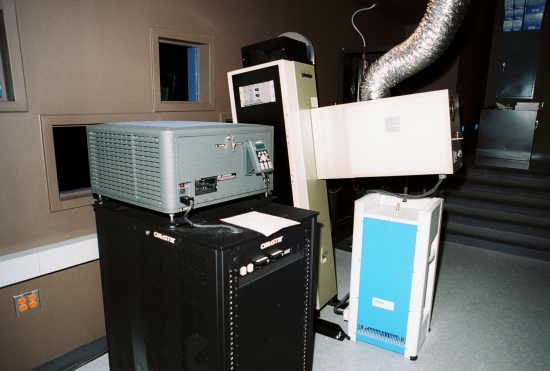|
|
This topic comprises 2 pages: 1 2
|
|
Author
|
Topic: Port glass window styles and types comparison
|
|
|
|
|
Scott Norwood
Film God

Posts: 8146
From: Boston, MA. USA (1774.21 miles northeast of Dallas)
Registered: Jun 99
|
 posted 06-25-2011 04:19 PM
posted 06-25-2011 04:19 PM





Be aware that there may be fire or public-safety codes relating to this issue. Be sure to look into those before making a decision.
I strongly prefer small portholes (12" square seems to be standard). These keep the amount of light and noise leakage into the auditorium to a minimum. Since projection ports should use proper (and expensive) optical glass, small portholes will keep this cost to a minimum.
My "ideal" booth would have one set of portholes (projection and viewing) per film projector (no viewing port is needed for a video projector), an additional set of portholes with shutters (for a second or third projector, slide projector, 16mm projector, video projector, etc.), and a large (maybe 3' square) port with a shutter. You never know what equipment might be needed in the future (followspot? DLP projector? 16mm projector? something else?), and it is best to prepare for this possibility now. Normally, the shutters on the "extra" ports can remain closed to reduce light leakage.
Also, please make sure that at least one of the viewing ports can be opened from within the booth. This is useful for quick checks of sound volume and also in case cables ever need to be run between the auditorium and the booth.
Unfortunately, the trend (especially in multi-use facilities) seems to be towards either giant portholes that span the length of the booth, or ones that are large enough to allow a single porthole to be used for both projection and viewing. I hate these. ![[Mad]](mad.gif) The only real advantage that I can see is that they give additional flexibility for future equipment additions at the cost of serious noise and light leakage issues. The only real advantage that I can see is that they give additional flexibility for future equipment additions at the cost of serious noise and light leakage issues.
One more trend that I dislike is for a video projector to be installed between two 35mm projectors. In one such installation, the architect actually included a separate viewing port for the video projector ![[Roll Eyes]](rolleyes.gif) . Coupled with a very short throw, the keystoning in that venue was quite bad. Please do not do this without a really good reason. . Coupled with a very short throw, the keystoning in that venue was quite bad. Please do not do this without a really good reason.
| IP: Logged
|
|
|
|
|
|
|
|
|
|
Frank Angel
Film God

Posts: 5305
From: Brooklyn NY USA
Registered: Dec 1999
|
 posted 06-29-2011 03:35 PM
posted 06-29-2011 03:35 PM





Large, wall-to-wall openings seem to be the darlings of architects and multi-function facility operators because they allow the audience to see all that high-tech equipment which the operator just paid big bucks for. And I admit, it does have a wow factor, audiences looking up and seeing those big projectors and twinklying indicator lights, but that wow factor lasts about as long as it takes to say "wow." From that moment on, it's just misery for the projectionist.
One of the main things is, that such a construction almost ALWAYS will eschew real optical coated port glass because unless the organization wants to add a huge price tag just for the glass itself, they won't be able to afford the cost of a huge pane of real, optical quality, coated glass for such an install. So right off the bat, whatever else they put it will compromise the image on the screen; how insane to design THAT into a new projection booth?
Next, any operator will find they need to work in near darkness because such a projection "wall" makes controlling booth light spill into the theatre nearly impossible. In the booth in which I work where there is such a window, we can use no general lighting at all and have to run the show using only Little-Lites for illumination, and even those need to be aimed carefully. And you'd better plan to have all the booth walls painted flat black because anything else will reflect light back into the theatre and onto the screen. We had to even take down a small bulletin board on the back wall because, pin a few time schedules to it and the white paper reflected light back onto the screen. And such a large window is very difficult and costly to try to angle it, so be sure they will want to set it like a normal window, i.e., parallel to the walls and that has it's own sets of problems because it reflects that projection beam right back at the projector lens and the metal on the projector body which in turn reflets it back into the theatre and onto the screen.
We found in one instance the window was reflecting a perfect second image from the lens front element back onto the screen causing the image look soft focus. It took us hours to figure out what was wrong with the projector, the lens, the gate and all the other possibilities we considered. Nothing was! It was the damn window.
If you can't easily reach the glass from the theatre side, you'd better make absolutely sure the port glass can be removed for cleaning -- angled or not, it will get dirty (btw, angling the glass is not to keep it clean, it's to reduce reflections both light and sound). You really don't want to have to put scaffolding up every time you need to clean the port glass.
And like everyone says, the sound leakage from booth into the theatre with large windows is a big issue. We couldn't talk in a normal conversational voice without being heard in the balcony.
| IP: Logged
|
|
|
|
|
|
|
|
|
|
|
|
|
|
|
|
|
|
All times are Central (GMT -6:00)
|
This topic comprises 2 pages: 1 2
|
Powered by Infopop Corporation
UBB.classicTM
6.3.1.2
The Film-Tech Forums are designed for various members related to the cinema industry to express their opinions, viewpoints and testimonials on various products, services and events based upon speculation, personal knowledge and factual information through use, therefore all views represented here allow no liability upon the publishers of this web site and the owners of said views assume no liability for any ill will resulting from these postings. The posts made here are for educational as well as entertainment purposes and as such anyone viewing this portion of the website must accept these views as statements of the author of that opinion
and agrees to release the authors from any and all liability.
|

 Home
Home
 Products
Products
 Store
Store
 Forum
Forum
 Warehouse
Warehouse
 Contact Us
Contact Us




 Printer-friendly view of this topic
Printer-friendly view of this topic







![[Mad]](mad.gif) The only real advantage that I can see is that they give additional flexibility for future equipment additions at the cost of serious noise and light leakage issues.
The only real advantage that I can see is that they give additional flexibility for future equipment additions at the cost of serious noise and light leakage issues.![[Roll Eyes]](rolleyes.gif) . Coupled with a very short throw, the keystoning in that venue was quite bad. Please do not do this without a really good reason.
. Coupled with a very short throw, the keystoning in that venue was quite bad. Please do not do this without a really good reason.










